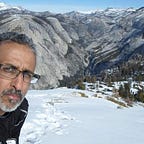Assimilation Misunderstood — Why the Poway Chabad shooting and others like it happen.
Poway is not a racist community. It is unfortunate this has to be said, but it does in order to have an honest conversation about why incidents like this past weekends synagogue shooting happen in seemingly good, wholesome, and small American cities. And an honest and insightful discussion is not one about about the statistical trivialities of the hate crime: how many were killed, who was the gunman, what type of weapons were used or where does this atrocity rank among others.
I grew up in the majority white San Diego County town of Poway in the ’70s and ’80s. As a child, I explored in the field next to the Lutheran church where eventually the Chabad of Poway would be built and where last weekend a shooter opened fire during Sabbath services.
Poway has always been an odd mix of sports stars’ homes and mansions on the north side, and ranches and horse corrals on the south. Poway flourished over the last 50 years for reasons similar to the Bay Area, where small cities like Walnut Creek on the edge of Silicon Valley thrived amid a regional tech boom. While many immigrant families overlooked Poway as too rural, some (like my Indian immigrant parents) were drawn to its good schools, affordable homes and proximity to work.
To understand why horrible events happen in places like Chabad of Poway, or at the Tree of Life synagogue in Pittsburgh, or the Sikh Gurdwara in Oak Creek, Wis., we have to examine the idea of cultural assimilation of minorities in America. America’s founders gave a lot of thought and debate to immigrant assimilation, eventually and correctly understanding that it is civic and patriotic assimilation, not cultural assimilation, that must be achieved. Proper assimilation benefits American society as a whole, while giving the individual access to American freedom and prosperity.
Thriving as a member of a minority in a small homogeneous American city like Poway was, and surely still is, entirely about fitting in. One must do what the majority around them does — not only to assimilate, but also to avoid standing out. One’s imported culture, language, behavior, food and religion are often kept at home, where they cannot be judged. This is the trade-off minorities make for access to American prosperity, and freedom from ridicule, criticism, even violence.
But when some in the majority use the expectation of assimilation as a way to assuage their own fears of losing dominance, the results can be devastating.
If an immigrant group doesn’t appear to quickly adopt American habits, norms of dress, language, food, entertainment, work — even worship and morals — then some are apt to view the group as threatening.
But what seems to spark deeper fear is not the actions or beliefs of the minority, but rather members of their own majority tolerating the minority’s culture, language and beliefs. It’s this fear — that people like them are willingly relinquishing cultural dominance — that is the source of anger. Further encouraged by like-minded individuals or what they read or see online, these social outliers might join hate groups or act out violently in attempts to reaffirm their own identity and societal status.
This misapplied view of assimilation is not conceived in a vacuum by a few bad actors, however; it is unknowingly fueled by their community leaders. Take, for instance, Poway’s slogan, “The City in the Country” — which is presumably a nod to a more preferred past, when the sun-drenched town was comprised of just hard-working Americans tending their horses and cattle. Or consider the subliminal influence of the country singer turned mayor of Poway, Steve Vaus, whose 1992 hit song is titled, “We Must Take America Back.”
Communities like Poway aren’t alone in embracing these messages; many Americans lately seem to have left well-intended patriotism for a nefarious nationalism.
While optically those symbols and gestures appear to be well-intended Americanism, they are often misinterpreted by some in the majority as yardsticks and gauges by which to measure the assimilation of minorities in their community. Communities that brand and market themselves solely on their history and traditions often are ignorant of how far those Americanisms can reach.
For instance, the schools I attended in Poway in the ’70s fastidiously celebrated Christmas, as they should. But now, in 2019, should those schools celebrate a diversity of holidays representing the full range of religious traditions of its community members? Surprisingly, they don’t.
Quite a few Americans still believe Christmas is inseparable from Americanism, and therefore all others must embrace it to fully assimilate in American culture. This notion is entirely counter to what the founders set forth. As Thomas Paine wrote in The Rights of Man,
“If there is a country in the world where concord, according to common calculation, would be least expected, it is America. Made up as it is of people from different nations, accustomed to different forms and habits of government, speaking different languages, and more different in their modes of worship, it would appear that the union of such a people was impracticable; but by the simple operation of constructing government on the principles of society and the rights of man, every difficulty retires, and all the parts are brought into cordial unison.”
Civic leaders in American cities large and small need to foster the right kind of patriotic assimilation while rooting out their own objectors. The uniting of various peoples with diverse religious identities and ethnicities around common civic values is, in fact, what makes America unique.
Chirag Asaravala lives and writes in the East Bay. Originally published at https://www.sfchronicle.com on May 2, 2019.
